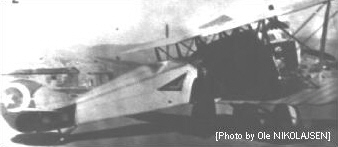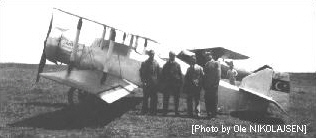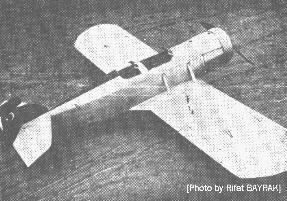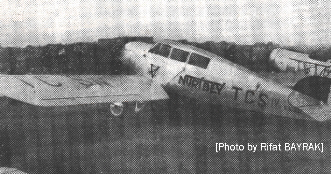 | |||
Vecihi HÜRKUS: | |||
The extremely successful military pilot Vecihi HÜRKUS (translated: FREE BIRD) began to design his own aircraft after the end of World War I and the following War of Independence. At first he built the two-seat
reconnaissance aircraft Vecihi K-VI
from surplus and as well as from captured aircraft parts. The officials of the national licensing commission, who were assigned to license the new aircraft, were however not capable of it. To mask their inability, they delayed with weak arguments, the issuing of the so much desired license. Annoyed about this incompetence, Vecihi HÜRKUS finally carried out the first flight of the K-VI without their permission. The successful 15 minute first flight of the K-VI took place on 28.01.1925 at Izmir. As a result of this first flight he was
condemned to a 15-days detention, and the first Turkish designed aircraft was scrapped on official decree. In 1930 Vecihi HÜRKUS built his second aircraft, the Vecihi XIV. It was a two-seat multi-purpose aircraft. The first flight took place on 16.09.1930 at Istanbul. After the test phase, he flew with his Vecihi XIV to Ankara and tried to get the license again. On 14.10.1930 he got the official message that “the permission (could not) be
granted, because nobody in Turkey (was) capable of it”. After much urging, he convinced the authorities to grant him the license, even if it was done by the Czechoslovakian admission’s authorities. Despite the innumerable chicaneries Vecihi HÜRKUS kept building aircraft. In 1933 he developed the three-seat multi-purpose aircraft Vecihi XV in semi-metal building method. In 1934 the Vecihi XVI was built, a four-seat-cabin monoplane. Later the Vecihi XIV and the Vecihi XVI were set on floats and flown as Vecihi XIVD and Vecihi XVID. The abbreviation D means Deniz (the sea). In 1938 Vecihi HÜRKUS built his last aircraft, the Vecihi K-XVII. Unfortunately no further information could be found on this high-wing monoplane. It is remarkable that none of his aircraft ever received an official Turkish license. Nevertheless Vecihi HÜRKUS found a way to fly his aircraft. On 21.04.1932 he founded at Istanbul the first Civil Flying School of Turkey, the Vecihi Sivil Tayyare Mektebi. On 27.09.1932, as the training began, 12 students pilots were enrolled, including two female flying students. In the Flying School Vecihi HÜRKUS´ designed aircraft was exclusively used. Because of the difficulties with the authorities and not in the least bit form financial reasons, the school had to stop operations in 1934. One of the hidden reasons for his difficulties with authorities, was the fact that he was not sufficiently educated. In order to solve this problem once and for all and naturally in order to follow after his affinity for aeronautics Vecihi HÜRKUS studied aircraft design at the Technical University in Weimar. On 29.02.1939 he got his diploma as an aircraft designer. When he returned afterwards to Turkey, surprisingly though it may seem, his diploma was recognized only after a court order. After World War II he tried to share his aeronautical knowledge with young students. In this way he created in 1947 the Wing Union, the Kanatlilar Birligi. The flights were carried out with a Miles Magister aircraft procured from the Turkish Aeronautical Association (THK). Vecihi HÜRKUS also tried to work as a businessman. He and five colleagues founded the company Turkish Wings (Türk Kanadi) in 1951. They procured from Great Britain three Auster Mk.V aircraft to execute agricultural flying in Turkey. But after a disagreement among the partners he left the company. One year later he carried out, in his one-man company, advertisement flights for baby food with a Percival Proctor V. On 29.11.1954 he founded the first civilian airline of Turkey, the Freebird Airlines (Hürkus Hava Yollari). With altogether 8 DH-86B Dragon Express/DH-89A Dominie/DH-90 Dragonfly, a DH-82A Tiger Moth and a Miles M.57 Aerovan aircraft, recovered from the national Turkish Airlines, he tried to carry passengers and freight. He had to fight again with substantial official obstacles, so he flew with his last remaining aircraft investigation flights over Anatolia on behalf of the National Ore Research Institute (Maden Tetkik Arama Enstitüsü). In summary it can be said that the ingenious pioneer Vecihi HÜRKUS was substantially obstructed in his attempts in the field of aeronautics and finally sank into ruin from the officials’ incompetence and their arbitrariness, and not hardly from envy from those around him. He died disappointed on 16.07.1969. |
|
|
[Home] [DEUTSCH] [ENGLISH] [LINKS] [T. DENIZ] [Buch/ Book] [Civil. Aircraft] [TuAF Phantoms] |



